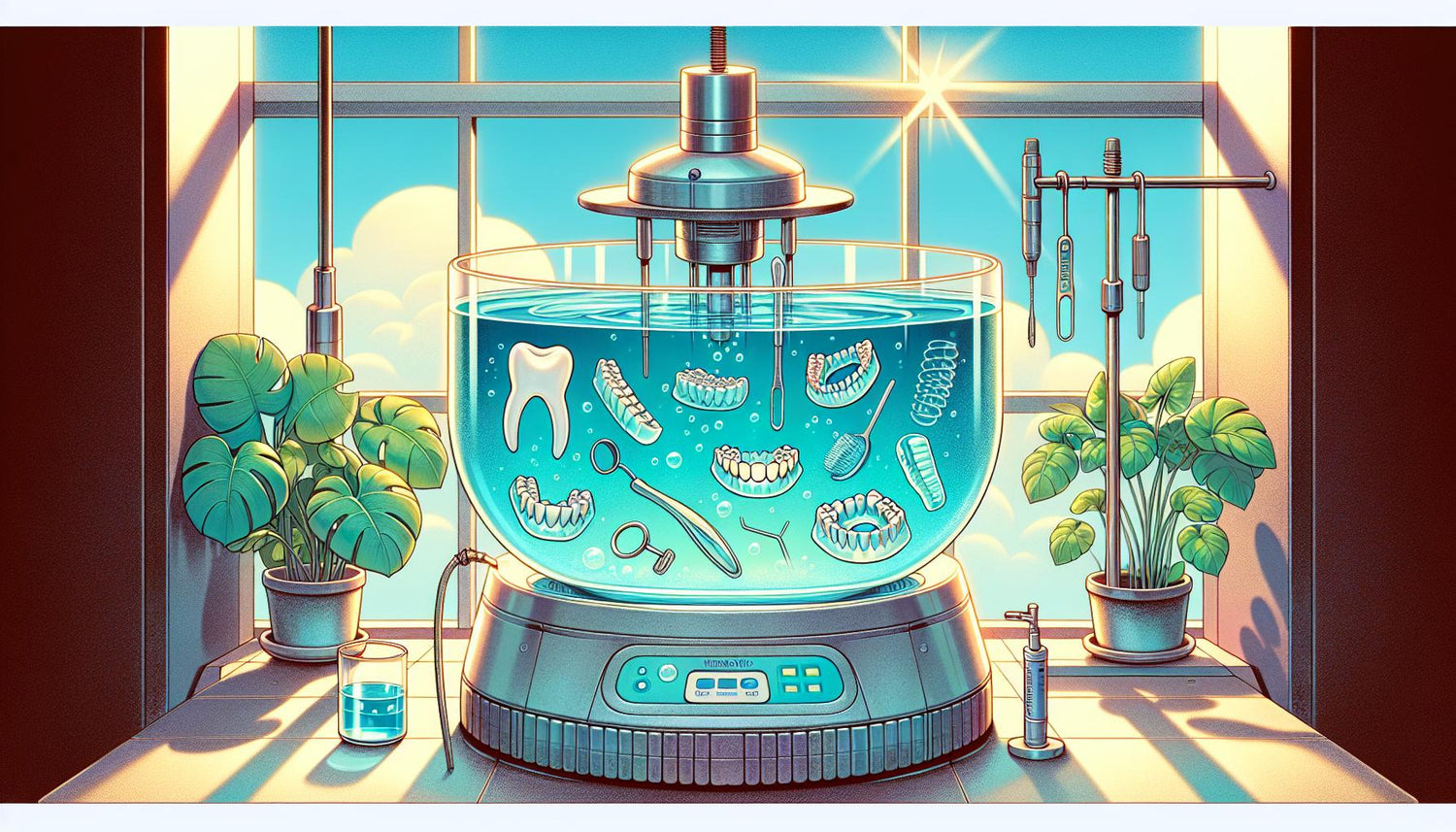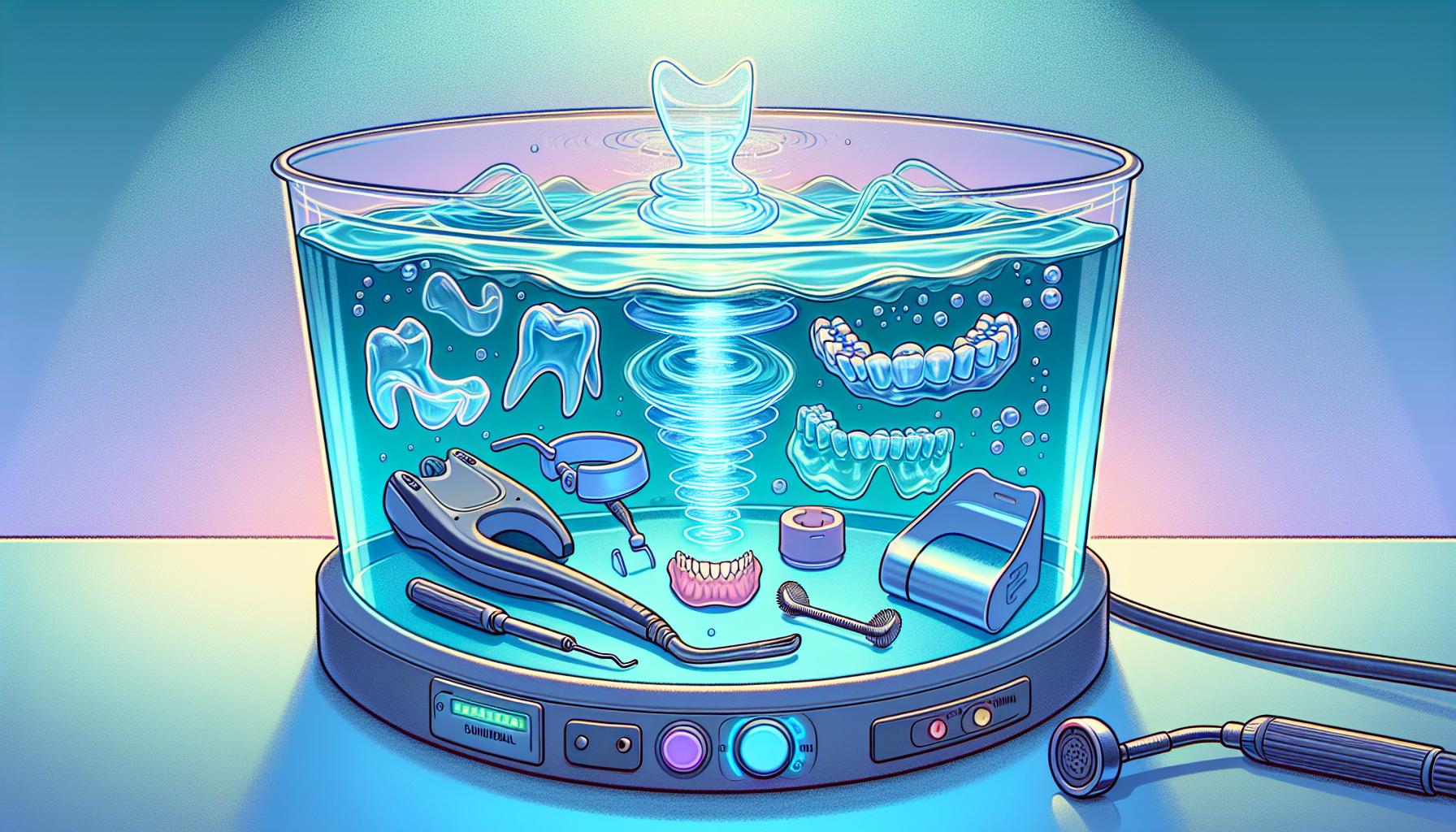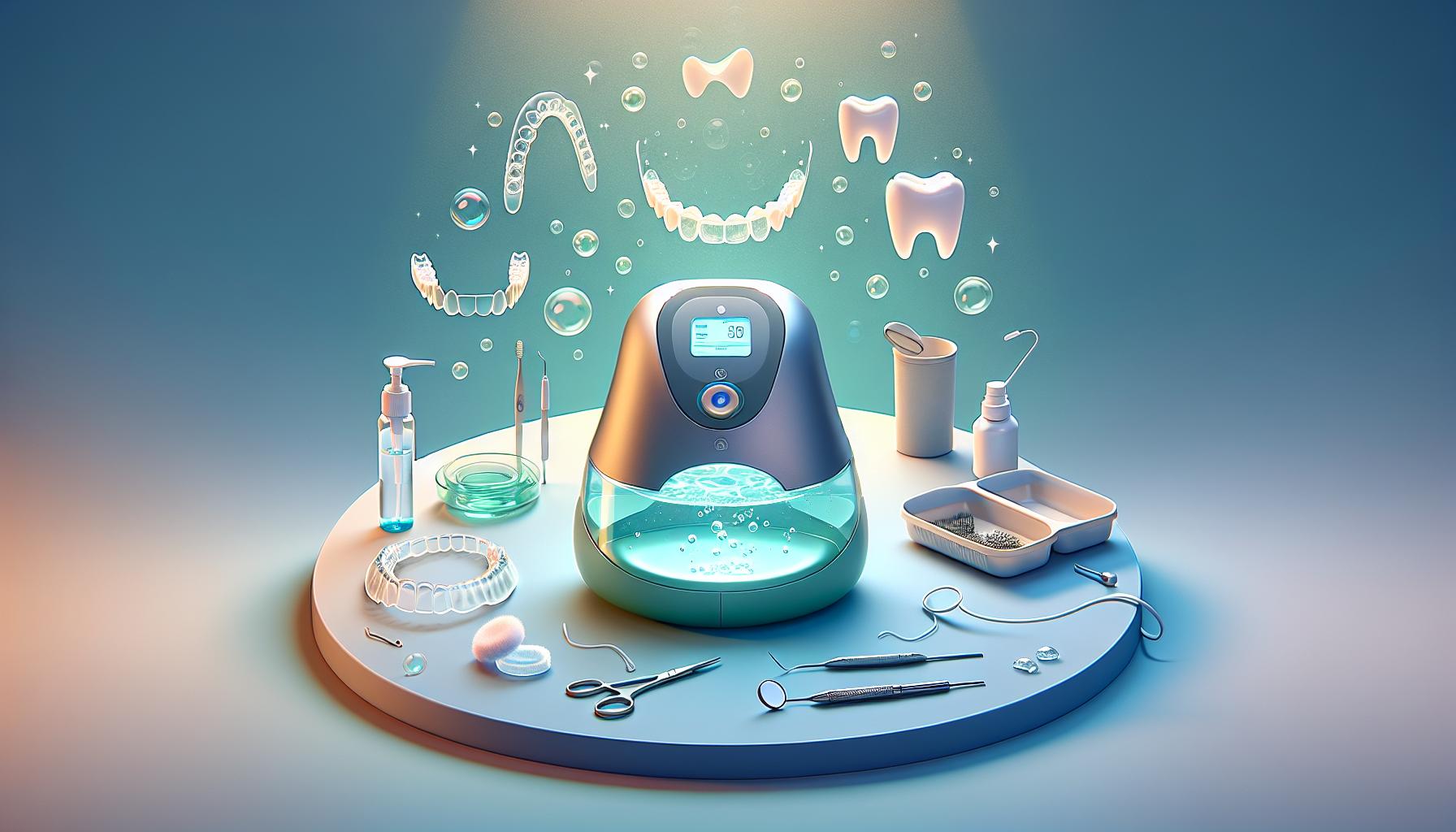The Evolution of Dental Appliance Cleaning
Dental appliances – from retainers and Invisalign trays to dentures – have become essential to many people’s daily lives. Unfortunately, these devices can harbor bacteria, plaque, and other build-up that diminishes their effectiveness and potentially leads to oral health issues. Traditionally, people have relied on chemical solutions or manual brushing approaches that often include ingredients not ideally designed for prolonged contact with these sensitive devices.
The Problems with Traditional Chemical Cleaners
- Harsh Chemicals: Conventional chemical cleaners might include ingredients that, while effective at killing germs, can also damage the structural integrity of your retainer or Invisalign tray over time. Frequent exposure to damaging chemicals can lead to microscopic cracking or discoloration, ultimately shortening the appliance’s lifespan.
- Taste and Odor: Some chemical solutions leave behind residues that result in an unpleasant taste or odor. These remnants can be challenging to rinse off completely.
- Potential Allergies: Certain users may develop sensitivities or allergic reactions to ingredients within harsh cleaning solutions. The safety profile of such products is of great concern, especially when used daily.
- Environmental Impact: Many chemical cleaners are not environmentally friendly, creating an additional burden on waste management and water systems.
Given these concerns, the dental industry has seen an increasing interest in alternative cleaning methods that avoid harsh chemicals. This is where ultrasonic cleaning technology stands out.
Understanding Ultrasonic Cleaning Technology
Ultrasonic cleaning uses high-frequency sound waves to generate microscopic bubbles in a cleaning solution. This process, known as cavitation, produces rapid bursts of energy that dislodge debris, plaque, and bacteria from the surfaces of dental appliances. Here’s how it works:
- Cavitation Process: When an ultrasonic transducer sends high-frequency sound waves through a cleaning solution, tiny bubbles form and collapse. This bursting action creates microjets of liquid that reach every crevice of your retainer or any dental appliance.
- Thorough Cleaning: The cavitation process ensures that bacteria and debris are removed even in areas that a manual toothbrush would miss. This makes an ultrasonic retainer cleaner particularly effective in maintaining hygiene.
- Minimal Chemical Use: Although some ultrasonic cleaning machines can work with a small amount of cleaning solution to enhance the process, many systems require only a safe, simple cleaning agent. This significantly reduces the potential for harsh chemical exposure.
Ultrasonic vs. Chemical Cleaning
- Gentle Yet Effective: The power of ultrasonic waves effectively cleans without the need for aggressive cleaning agents, preserving the device’s physical properties.
- Even Coverage: The sound waves reach all nooks, crannies, and crevices, ensuring that the cleaning process is both thorough and gentle.
- Eco-Friendly: With minimal reliance on harsh chemicals, ultrasonic cleaning is better for the environment. This technology often uses neutral solutions that have a reduced environmental footprint.
- Increased Longevity: By avoiding the corrosive effects of chemical cleaners, your device maintains its structural integrity for a longer period.
These benefits are a big reason why many consider the ultrasonic retainer cleaner to be one of the safest cleaning devices available.
Safety Factors in Ultrasonic Devices
When evaluating the safety of a dental appliance cleaner, several factors must be taken into account. Here are some critical elements that contribute to a safe and effective cleaning process:
Material Compatibility
Ultrasonic cleaners are known for their compatibility with a wide range of materials. Whether your appliance is made from acrylic, polymers, plastics, or metals, ultrasonic waves do not damage these surfaces. This compatibility is crucial when using an ultra sonic cleaner for retainer because it guarantees that your retainer remains in pristine condition long-term.
Avoidance of Harsh Chemicals
The primary advantage of ultrasonic cleaning is the reduction or elimination of harsh chemicals. By using only a minimal amount of a gentle cleaning agent, manufacturers promise a low-risk procedure for cleaning your dental appliances. For example, with the best ultrasonic retainer cleaner, users can trust that their devices undergo effective cleaning without the risk associated with aggressive chemical exposure.
FDA-Approved Designs
Many ultrasonic cleaning devices are designed and regulated under strict medical and dental standards. High-quality machines, including the retainer cleaner machine and best retainer cleaner machine, undergo rigorous testing and are FDA-approved, ensuring that they are safe for daily use. This approval provides a level of trust and confidence that not only are they effective, but they’re also safe for both users and the dental appliances themselves.
User-Friendly Operation
Modern ultrasonic cleaning devices are built to be as user-friendly as possible. With programmable settings, auto shut-off features, and clear instruction manuals, these devices are designed so that users can operate them safely without the risk of user error. Their design rounds out the considerable benefit of consistently providing a safe and efficient cleaning method without complication.
Advantages of Using an Ultrasonic Retainer Cleaner
Ultrasonic cleaning devices have quickly risen in popularity because they offer a multitude of benefits. Below is a detailed discussion of why these devices are preferred in dental hygiene routines:
Superior Cleaning Efficiency
Due to the cavitation process generated by high-frequency sound waves, an ultrasonic retainer cleaner reaches all parts of a dental appliance. This process ensures that all harmful microorganisms, plaque, or even stubborn debris are removed from your retainer. Whether you’re using an ultrasonic invisalign cleaner or another type of device, this mechanism provides an exceptionally deep clean that is difficult to achieve manually.
Convenience for Daily Maintenance
The convenience of placing your appliance in a cleaning solution and letting the device do the work cannot be overstated. This simplicity is part of the appeal for many who struggle with meticulous hand-cleaning routines. The process streamlines your oral care routine while ensuring that every nook of your appliance is cleaned. For anyone interested in cleaning dentures with ultrasonic cleaner, the ease of use is a clear benefit.
Prolonged Appliance Lifespan
By avoiding the degradation of your dental appliance material, ultrasonic cleaning helps maintain both the appearance and strength of your retainer or denture. The method minimizes the risk of microscopic cracks or color changes that might arise from prolonged exposure to certain chemical agents.
Health and Hygiene Benefits
Ultrasonic cleaning not only improves the longevity of your dental appliances but also promotes better overall oral health. The removal of biofilm, bacteria, and plaque reduces the risk of oral infections, gum disease, and other related health concerns. Using a device such as the best ultrasonic retainer cleaner can be a proactive step in maintaining a healthier mouth environment.
How to Choose the Best Ultrasonic Retainer Cleaner
Selecting the right ultrasonic cleaning machine for your dental appliances involves evaluating several features. Here are some key factors to consider:
1. Device Specifications
- Frequency and Power Output: The cleaning efficacy largely depends on the frequency of the ultrasonic waves. Look for devices that offer a consistent frequency tailored for delicate dental appliances.
- Tank Size: The size of the cleaning chamber should suit the type of appliances you intend to clean regularly, whether it’s a retainer, denture, or Invisalign tray.
- Cycle Duration: The best devices allow you to select varying cycle durations depending on the level of cleanliness required. Some advanced models even offer customizable settings.
2. Ease of Use
- User Interface: A simple, intuitive interface ensures that even those unfamiliar with ultrasonic technology can operate the machine safely and effectively.
- Cleaning Solution Requirements: Some devices may require a minimal amount of a cleaning solution to work best. Always choose a machine that guides you toward a chemical-free or mildly enhanced cleaning process.
- Maintenance: Consider devices that are easy to maintain. A straightforward cleaning and maintenance process can ensure that your ultrasonic device remains hygienic and operational.
3. Safety Features
- Auto Shut-Off: An auto shut-off feature helps prevent potential overheating and ensures that the device does not run for longer than necessary.
- Overload Protection: This feature protects the machine from power surges or improper usage, further adding to the overall safety.
- Certifications: When possible, choose a product that has certifications from recognized dental or medical bodies. This ensures that the device meets stringent safety and quality criteria.
4. Versatility in Appliance Cleaning
- Multi-Purpose Usage: Look for models capable of cleaning a variety of dental appliances. Products advertised as the best retainer cleaner machine often have the versatility to also serve as an ultrasonic invisalign cleaner or even for cleaning dentures with ultrasonic cleaner.
- Adjustable Settings: Devices that offer multiple cleaning modes can adapt to different cleaning needs, whether you require a quick rinse or a deep clean.
5. Price and Warranty
- Budget: While high-end models might come with advanced features, many mid-range devices also offer excellent performance. It’s important to balance cost with quality.
- Warranty and Support: A reliable warranty and customer support system add considerable value, ensuring you have assistance if you run into any issues.
By considering these factors, you can select an ultrasonic cleaning device that not only meets your specific dental appliance cleaning needs but also guarantees safety and longevity.
Use Cases Beyond Retainers
While retainers and Invisalign trays are common appliances for using an ultrasonic cleaning machine, the technology has much broader applications:
Cleaning Dentures with Ultrasonic Cleaner
Traditional methods of cleaning dentures often rely on soaking agents that may include ingredients to combat odors and stains. With an ultrasonic retainer cleaner, the same technology can be adapted for cleaning dentures. The ultrasonic cleaning process can remove plaque, bacteria, and any food particles lodged in the crevices, effectively reducing the need for chemical-based cleaning solutions. This approach makes it an ideal solution for those looking for a gentler mode of hygiene maintenance.
Maintaining the Hygiene of Other Dental Appliances
Beyond dentures, the versatility of ultrasonic cleaning technology extends to other dental devices, including night guards, retainers made from different materials, and even certain orthodontic appliances. Each of these devices benefits from the non-aggressive cleaning method offered by ultrasonic waves, maintaining both hygiene and structural integrity.
Cost-Effective Long-Term Savings
Investing in a high-quality ultrasonic cleaning device can reduce the need for frequent replacements of dental appliances. Since the cleaning process avoids harsh chemicals, the appliances remain in good condition for longer periods. Over time, this not only saves money but also contributes to a sustainable lifestyle by reducing waste.
Addressing Common Concerns About Ultrasonic Cleaning
While ultrasonic cleaning technology offers many benefits, it’s natural for users to have concerns when switching from traditional methods. Below, we address some of the most frequently asked questions:
Does Ultrasonic Cleaning Damage My Appliance?
Ultrasonic cleaning is designed to be gentle. The micro-bubble cavitation is controlled in such a way that it dislodges debris without compromising the integrity of the materials. Whether you’re using an ultrasonic invisalign cleaner or another device, the process is thoroughly safe if manufacturers’ guidelines are followed.
Are There Any Residues Left Behind?
One of the standout features of ultrasonic cleaning is its ability to clean thoroughly without leaving behind chemical residues. This is particularly beneficial when compared to traditional cleaning solutions that sometimes require extensive rinsing. Users will appreciate the fresh, neutral state of their appliances after undergoing an ultrasonic cleaning cycle.
How Often Should I Use an Ultrasonic Cleaner?
For optimal hygiene, using an ultrasonic cleaning device several times a week is generally recommended, depending on personal usage. Daily cleaning might be ideal for individuals who wear their appliances continuously, ensuring that bacteria and plaque buildup are kept at bay. It’s always a good idea to follow both your dentist’s advice and the cleaning device’s recommendations.
Is It Safe for Sensitive Users?
Because ultrasonic cleaning minimizes chemical exposure, it is safer for individuals with sensitivities or allergies to specific chemicals found in conventional cleaning agents. This makes ultrasonic devices a smart choice for households with diverse needs.
Future Trends in Ultrasonic Dental Appliance Cleaning
Advances in ultrasonic technology continue to refine the cleaning process. Future trends in this area could include:
Integration with Smart Technology
Imagine a retainer cleaner machine that integrates with your smartphone. With built-in sensors and connectivity, future devices could track the cleaning cycles, provide alerts when cleaning is due, and even adjust settings based on the type of appliance being cleaned.
Eco-Friendly Innovations
As environmental awareness grows, there is an increased demand for eco-friendly cleaning devices. Advances in ultrasonic technology are expected to focus on reducing energy consumption and utilizing even more benign cleaning solutions, reinforcing the eco-friendly benefits of using an ultrasonic retainer cleaner.
Enhanced Customization Options
Future models may offer greater customization, adapting to a wider range of dental appliances while offering unique modes for delicate materials versus more robust ones. Innovations in control panels and interface design could make the process even easier for users seeking the best retainer cleaner machine for various needs.
Expanded Educational Outreach
As adoption increases, manufacturers and dental professionals are likely to offer more comprehensive education on the benefits and proper use of ultrasonic cleaning. This will further cement the role of devices like the ultra sonic cleaner for retainer in everyday dental hygiene routines.
Tips for Maximizing the Benefits of Your Ultrasonic Cleaner
- Follow Manufacturer Instructions: Every model has unique parameters for optimal use. Always adhere to the instructions provided to ensure the safety and longevity of both your device and your dental appliances.
- Select an Appropriate Cleaning Solution: While many ultrasonic cleaners work best with a neutral cleaning solution, some models allow for gentle additives that bolster cleaning power without resorting to harsh chemicals.
- Regular Maintenance: Clean the ultrasonic cleaner itself to ensure that no residues build up over time. A maintenance routine extends the life of your device and ensures consistent performance.
- Keep Track of Cleaning Cycles: Regular cleaning helps maintain oral hygiene. Use the recommended cycle durations and frequencies to ensure that all debris, bacteria, and plaque are removed consistently.
- Educate Yourself: Stay informed about the latest advancements in ultrasonic cleaning technology, helping you find the best ultrasonic retainer cleaner models and keep up with improvements that may enhance your cleaning routine.
Conclusion
In the quest for maintaining a hygienic and safe oral care routine, ultrasonic cleaning technology stands out as a revolutionary method capable of cleaning dental appliances thoroughly without the risks associated with harsh chemical agents. Whether you’re using an ultrasonic retainer cleaner for your daily needs or exploring options like an ultrasonic invisalign cleaner for your clear aligners, the advantages are considerable.
By understanding the science behind ultrasonic cleaning and its safety features—from material compatibility and minimal chemical exposure to user-friendly operation and eco-friendly benefits—dental appliance users can be confident that this technology preserves the integrity of their devices while promoting optimal oral health.
For anyone seeking the best retainer cleaner machine or a versatile retainer cleaner machine that can handle everything from retainers to dentures, investing in ultrasonic cleaning technology is a smart decision. Not only does it enhance the longevity of your appliances, but it also supports a healthier lifestyle by reducing risks associated with harsh chemicals.
As the technology continues to evolve, future trends promise even greater efficiency and customization, making it clear that ultrasonic cleaning is not just a passing trend but a lasting revolution in dental hygiene. With these advancements, maintaining a fresh, safe, and hygienic oral environment is easier than ever.
Embrace the future of dental appliance care with ultrasonic cleaning technology and join the growing number of users who have discovered that the truth behind harsh chemicals lies in the gentle yet effective power of sound waves. Whether you’re cleaning dentures with ultrasonic cleaner or ensuring that your retainer is always in pristine condition, this technology is paving the way for a brighter, cleaner, and more sustainable future for oral health care.
By choosing a reputable ultrasonic cleaning device and adhering to best practices, you can enjoy a level of cleanliness that traditional chemical-based methods simply can’t match. As more dental professionals and users continue to embrace these innovations, the shift towards safe, efficient, and environmentally responsible cleaning technologies is set to transform the way we maintain our oral appliances—and our overall health.


